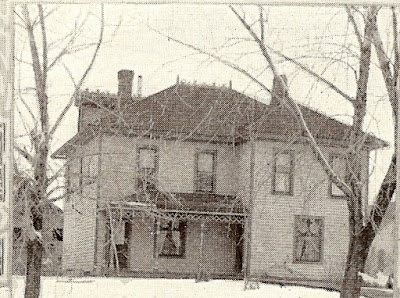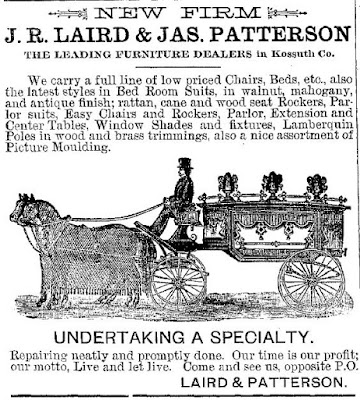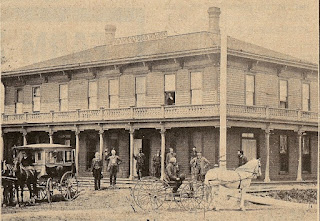In 1902, Ambrose A. Call wrote a series of articles for the Upper
Des Moines Republican recounting his experiences with Indians in the early days
of the settlement. The story of the raid on the Maxwell cabin was part of
his story and B. F. Reed later included it in the "History of Kossuth
County" which was published in 1913 and also in Harvey Ingham's book
"Old Indian Days" published in the 1920's. However, there was
so much more to his account than what was chronicled in either book. I was
fascinated to read the entire series -- particularly his description of his
meeting with Inkpadutah in his teepee. Over the next several weeks, I
want to share these articles with with you. We begin today with his
introduction and a portion of the Maxwell story.
A Memoir of the Incursion of the Yanktonaas
By HON. AMBROSE A.
CALL
To
The Editor—In compliance with my various promises I will undertake to
write of some of the events in the early history of Kossuth county, the story
of which has never been published.
We are approaching the half century mile
post that marks the time since the first settlers reared their cabins and
contended with the savage Sioux for their possession. The old timers, our old friends, are rapidly
passing away and will soon all be gone, and the history of those first trials
and struggles will be irretrievably lost unless a record be made of them before
it is too late. The history of our
county should not only be written but it should be true. Our records should be kept straight. Those who know it should write it.
One very much dislikes to write of
himself or of events in which he took a prominent part, but when it is
desirable to keep a true history and there is no one else to write it for him,
possibly he may be justified in doing it himself. Before I begin to tell my Indian stories I
wish to correct a mistake which might later be taken as true and get into the
history of the county. Some friend
recently sent me a publication from Belmond, Wright county, in which a lady,
the daughter of one Mr. Hunt, I believe, states in a very interesting article
that her father and one Mr. Overacker explored the country west and made claims
in 1853 where the city of Algona and also Spirit Lake now stand. She says further that they intended to return
and hold them, but upon their return heard of the Indian troubles around Clear
Lake and the killing of Captain Hewett’s Winnebago boy and were deterred
through fear of the Indians. By
reference to history it will be seen that the Indian trouble spoken of occurred
in July, 1854, and their return was subsequent to that event. I have on the margin of an old book this
notation: “July 28th, I find
upon my return two parties, named Overacker and Hunt, have, during my absence,
marked out timber claims on sections 11 and 12, south of Asa’s claim.” No one made claims in Kossuth county prior to
the settlement made by my brother and myself.
For the two years prior to my coming to
Kossuth county I spent most of my time on the upper Mississippi river around
St. Paul and Fort Snelling and on the tributaries of the Saint Croix river; a
part of the time among the Indians, Sioux and Chippewas; and I learned a great
deal of the Indian sign language and quite a few words both of Chippewa and
Sioux. The sign language is identically
the same with all the tribes east of the Rocky mountains, but their word
language is very different. In the same
tribe each individual has his own pronunciation. A buffalo is a “titonka,” or “tionka,” or
“tetonka,” as you find your Indian.
“Titonka” also means a cow or ox or most
anything big; a big white man is at once saluted as “titonka wasecha;” so with
an elk, he is an “humpa” or “umpa” or “impah,” a moccasin or mitten or any
other thing leather is also called “umpah.”
They have no written language to hold them to a uniform pronunciation,
and besides have all manner of defects in their speech, with usually a lazy
grunt at the end of every word.
In the early part of July, 1855, a large
party of Sioux Indians, some forty tepees including the chief, Inkpadutah, came
into the settlement, the same party that created the panic and stampede on the
head waters of the Cedar, and came near capturing his excellency, Gov.
Hempstead, the year before, and who in 1856 terrorized the settlers on the
little Sioux, culminating their deviltry by the Spirit Lake massacre in March,
1857. This band of Indians came into the
settlement from the west and pitched their tepees on section 24, near Mark
Parsons’ present residence. My first
intimation of their presence was rather startling. My cabin door was open. I had just eaten a bachelor’s dinner and was
lying down reading the Missouri Republican, which Maxwell had brought me from
Ft. Dodge, when a ringing war whoop saluted my ears. I sprang to the middle of the room, seizing
my gun, but was met by a big guffaw from a burly Indian who instantly stood his
gun against the wall and held out his hand with a “How, how.” Of course he considered it only a joke. I was not quite so sure of it, but shook his
hand and said “How.” A squaw tagged
along after him with a few moccasins to trade.
My rifle was a large one, carrying an ounce ball, and the Indian,
noticing the caliber, pulled a crude ball pounded out of a bar of lead and
measured it in my gun. He asked to see
one of my bullets, and when he found it just fitted his shot gun he was much
pleased and proposed at once: “How swap
for umpah?” I found two pairs of
moccasins which fitted me, for which I gave him ten bullets. He told me he would return with more, which
he did, and I traded for enough to last me a year or more.
I inquired of my visitor how many tepees
there were and he opened both hands four times, indicating forty, and then
pointed the direction. After he left I
visited the village, near Barney Holland’s cabin. Some of the neighbors were there and they
were having some contention, as the Indians had turned their ponies in Holland’s
corn, had taken Holland’s large grindstone to the center of their village and
set Holland to turning it, and as many as could get around it were grinding
their tomahawks and knives. The
perspiration was pouring from Holland’s face and he seemed very tired. With the others I insisted upon their turning
their ponies out of the corn and also made Holland quit turning the
grindstone. We came near having an open
rupture with them, as they were very surly and stubborn, but finally the squaws
turned the ponies out of the corn and the bucks installed one of their own
number at the stone. The next day they
scattered through the settlement, visiting every cabin. Some they plundered, but where they found
white men in sufficient force to resist they merely begged for something to
eat. Two tepees were pitched near my
brother’s cabin, on the hill just west of the power house, and it was the
occupants of these tepees who frightened Mrs. Call, the story of which she
wrote for the reading circle in 1872, and the sequel to which Mrs. Blackford
wrote for the Advance. Of course my
brother’s family was in no danger from two Indians, as he had four or five
hired men boarding with him all the time.
The evening of the second day Mr.
Maxwell came to my cabin, seemingly somewhat alarmed, and told me that three
Indians had just left his cabin, that they were sullen and saucy, took what
they pleased and that he dared not resist them on account of his wife and
children, and asked me to come down and stay with him. I had made my home for some time with Mr.
Maxwell and knew him to be a courageous man, not to be frightened without
cause. He had recently returned from
Boonesboro with a large load of provisions and supplies which would naturally
tempt the cupidity of the Indians. I promised
Maxwell I would come down early in the morning.
The Indians made all their raids in the day time. I consequently started early without my
breakfast but found the Indians were there before me, as they were already
swarming inside when I arrived. There
were eleven lusty young fellows, each armed with a double barreled shotgun,
cocked and loaded with ball, also tomahawk and knife. They had the house turned inside out, so to
speak, when I got inside. Mrs. Maxwell
had a boarder named Craw, who was one of those nice, peaceable men, and who
believed it an evidence of cowardice to carry a gun or other weapon of defense;
he never did. Well I found Craw sitting
in a chair, his face as white as a sheet, suffering every imaginable indignity
from the young bucks. They had pilfered
his pockets and unbuttoned his clothes, were pulling his nose, ears and hair,
occasionally slapping him on the side of the head, and nearly knocking him to
the floor. He didn’t dare to move; he
was paralyzed with fear. I said to
him: “Craw, for God’s sake run if you
can’t fight,” and Maxwell told him to get out of there and make for the
brush. After a short time I noticed his
chair was empty, so he must have got out in some way. Maxwell told me he had but two chambers of
his revolver loaded and asked me to stand in front of him while he loaded the
remainder. He stepped behind the door
and I stood in front and, although his revolver was an old fashioned Colts
which loaded with powder and ball he did it very quickly, without being
seen. As I came out from behind the door
a big young Indian who seemed to be leader noticed a two bushel bag of corn
meal and started to drag it to the door.
I thought the time had come to take a hand, if we intended to resist at
all, so I sprang and took hold of the sack, telling him to stop, but with a
defiant grunt he jerked it out of my hand.
At this I grabbed the bag with my left hand and with my right caught him
under the chin, and as we were standing quite near the doorway he went out
violently, clutching the door as he went, nearly pulling shut and striking on
the back of his head. I stood the sack
up against the wall and stood beside it, Maxwell, with his revolver in his
hand, standing beside me. An ominous
silence came over the cabin when the Indian went out doors but presently one
who if not a chief was spokesman for the crowd, pulled his tomahawk out of his
belt and advanced toward me, asking me to feel the edge of it. I snatched it from him and stuck it in his
belt. Again he drew it out and held it
toward me and again I snatched it from him and stuck it behind his belt. He then in a loud, menacing voice told me
they would “nepo squaw and papooses” (kill the women and children). In an equally loud voice and with some
emphatic profanity—Indians mostly understand that—I told him as well as I could
that if he undertook it we would “nepo” every damned Sioux in the cabin. He then scoffed at the idea and counted two
“wasechas.” Then holding two hands high
over his head he opened them many times, saying: “Sioux!
Sioux!”
In those days, when the Indians wished
to terrorize the whites they called themselves Sioux, but at other times they
were “Yanktonaas.” Notwithstanding the
Indian’s loaded talk and brave actions he backed off and subsided when he
noticed Maxwell’s fingers playing nervously around the trigger of his
revolver. I think Maxwell understood
what the Indian meant when he threatened to “nepo” the squaw and papooses, and
Mrs. Maxwell understood a part of it, for Maxwell said that we must get Eliza
and the children out if we could, but he was afraid they would follow her. I asked him if he did not think he could get
their attention away from the door by giving them something to eat, to which he
replied that they day before they had boiled up a mess of corn meal, pork and
molasses and that he would try them on that.
So he put the stove boiler on the stove, filled it half full of water
and gave them a part of a bag of meal, some bacon and a jug of molasses. The young bucks at once began to build a fire
and stir in the stuff and soon got to quarreling over it, in which quarrel the
others, who had been sulking, took a hand.
I told Mrs. Maxwell that when Mr. Maxwell gave the sign to slip out, get
into the woods and run for Brown’s and tell John to run his horse over and tell
Asa and the boys we were having trouble at Maxwell’s cabin.
We watched our opportunity, and when the
Indians were all busy with their mush Maxwell partly closed the door. He and I stood between it and the Indians and
Mrs. Maxwell slipped out and got away without being noticed. The Indians continued to quarrel and fuss
over their mush and Maxwell delayed them as much as possible. They couldn’t make the fire burn well and the
water refused to boil. They set their
guns up beside the door and turned their whole attention to their breakfast,
occasionally one of them running and looking out of the door.
After the lapse of about an hour their
mush was done satisfactorily but was so hot they could not eat it. One of them looked out of the door towards
the west and cried out “Wasecha!
Wasecha!” others ran and looked out and returned in much excitement,
making a rush.
Stay tuned for the second chapter of "The Indian Raid of '55" which will be brought to you next week.
Stay tuned for the second chapter of "The Indian Raid of '55" which will be brought to you next week.
Until next time,
KC History Buff
If you enjoyed this
post, please don’t forget to “like” and SHARE to Facebook. Not a Facebook
user? Sign up with your email address in the box on the right to have
each post sent directly to you.
Be sure to visit the
KCHB Facebook page for more interesting info about the history of Kossuth
County, Iowa.
Reminder: The posts on Kossuth County History Buff are ©2015-16 by
Jean Kramer. Please use the FB “share” feature instead of
cutting/pasting.











